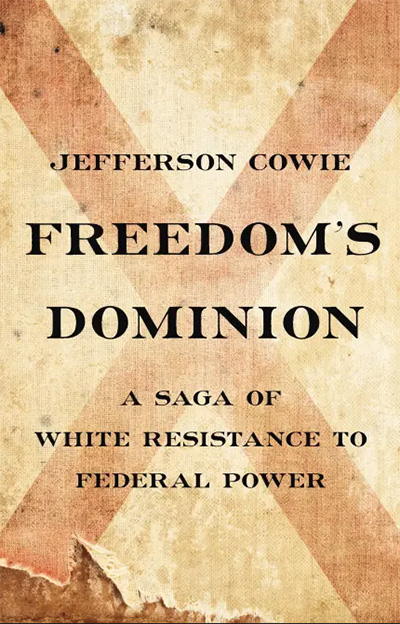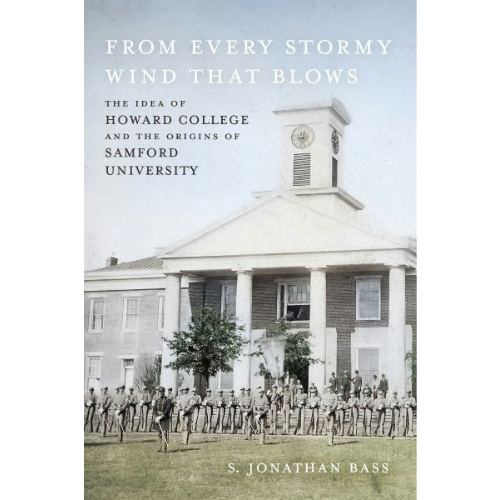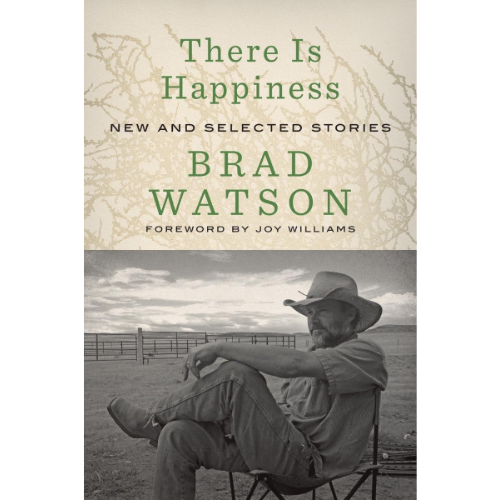By Jefferson Cowie
Basic Books, 2022
Cloth: $35.00
Genre: History
Reviewed by Foster Dickson

In his book’s section about the Civil War, historian Jefferson Cowie apprises the reader that neither Eufaula specifically, nor Barbour County more generally were significant locations in the fighting. So, in the scope of Southern history, many may not know about this place. However, the rest of the four-hundred-plus pages in his 2022 book Freedom’s Dominion make sure that we understand how significant this place is, to both the South and the nation. In a highly descriptive and richly detailed narrative, Cowie elucidates the difficult history of this eastern Alabama county, which borders the state of Georgia along Lake Eufaula, and connects that history into the patchwork of America.
Freedom’s Dominion begins with a weighty proposition about the concept of freedom. Though a common understanding would say that freedom is the ability to do as one pleases, Cowie’s proposition is that some Americans – Southerners, in particular – regard freedom as the ability not only to do as they please, but as the ability to dominate, control, and use others as they please. To illustrate that perspective and its accompanying tendencies, his narrative carries the reader from days before Alabama’s statehood, when white settlers were steadily encroaching on the Creek Nation, to modern times in the post-Civil Rights era. We begin with the region’s indigenous people and follow along as land speculators and other unrepentant white settlers violated treaties and behaved lawlessly, despite federal efforts to contain them. Along the way, there are unfamiliar names, like Hardeman Owens, who was killed by U.S. soldiers in a dispute over land, and as well as familiar ones, like President Andrew Jackson and “Star Spangled Banner” lyricist Francis Scott Key. During this time, Cowie tells us, anti-federal government sentiment took root over the issue of land rights, resulting in controversies and skirmishes among local whites, indigenous people, and U.S. officials. By the mid-nineteenth century then, the secessionist fire-eaters found their ideas well-received. Thus, the kiln of the frontier heated and hardened the belief that leaders in Washington, D.C. were not harbingers of democracy but a rotating swarm of interlopers whose efforts should be thwarted and undermined.
As this true story progresses, Cowie shows how the people in Barbour County would attempt repeatedly to build an empire on unsustainable foundations, yet remain resistant to interventions from outside. Eufaula had become an established and quite wealthy city in only a few decades during the cotton frenzy, then that prosperity ended. Scapegoating the federal government was an easy (and already traveled) political route to take, especially when the goals of the powerful few were the concentration of wealth and the elimination of interference. This political effort was furthered by the national political furor in the 1870s, as Republicans, Democrats, and splinter groups all tried to forge a new society in the wake of the Civil War and Reconstruction. Cowie devotes three chapters to the 1870s, which include more nationally recognizable names like editor Horace Greeley and others particular to Alabama, like the black congressman James T. Rapier and Thomas Goode Jones, who came to prominence working against the convict lease system. Through the first two sections and into the third, the author illustrates exceedingly well that his two premises – his idea about what freedom means to some, and the importance of Barbour County as a subject of study – are both viable and interesting.
What remains, at this near-midway point, is to traverse the most-recent century. By the end of the second section (of four), the twentieth century has brought on convict leasing, and the narrative introduces us to one of its masterminds, Barbour County’s J.W. Comer. Riding the tide of the Lost Cause mentality, a discussion of lynching brings the subject home with highly personal stories, and during the Depression, we read about a new kind of paternalistic autocracy that used sharecropping and mills to control black and white alike. The final chapter in this third section tells of Chauncey Sparks – the “Barbour Bourbon” – who served as Alabama’s governor during the years of World War II.
“Book Four: Democracy” is the last and longest section, containing six chapters and spanning more than one hundred pages. The prominent figure here is George Wallace, whose “Little Fightin’ Judge” persona catapulted him out of Barbour County, later to become a segregationist governor in the 1960s then a controversial presidential candidate in the 1970s. Wallace is not the sole focus, however. A dense and historically complex but still coherent narrative of the Civil Rights movement also swirls around the well-known (King, SCLC, CORE) and the local (Barbour County Voters’ League) alike. Moving into modern times, Cowie includes Wallace’s 1994 remark, “They all talking like me,” alluding to a now-familiar kind of politician who builds a career on defying the federal government. In the end, this history and subsequent current events tie back effectively to his original premise with an insightful question-and-answer, “Can Americans liberate themselves from the burdens of their freedom? Not easily.”
Foster Dickson is a writer, editor, and teacher in Montgomery. He is the author of Closed Ranks, the editor of Nobody’s Home and level:deepsouth, and the coordinator of the Fitzgerald Museum’s annual literary contest.





